2017 TOYOTA TACOMA fuel cap
[x] Cancel search: fuel capPage 449 of 640
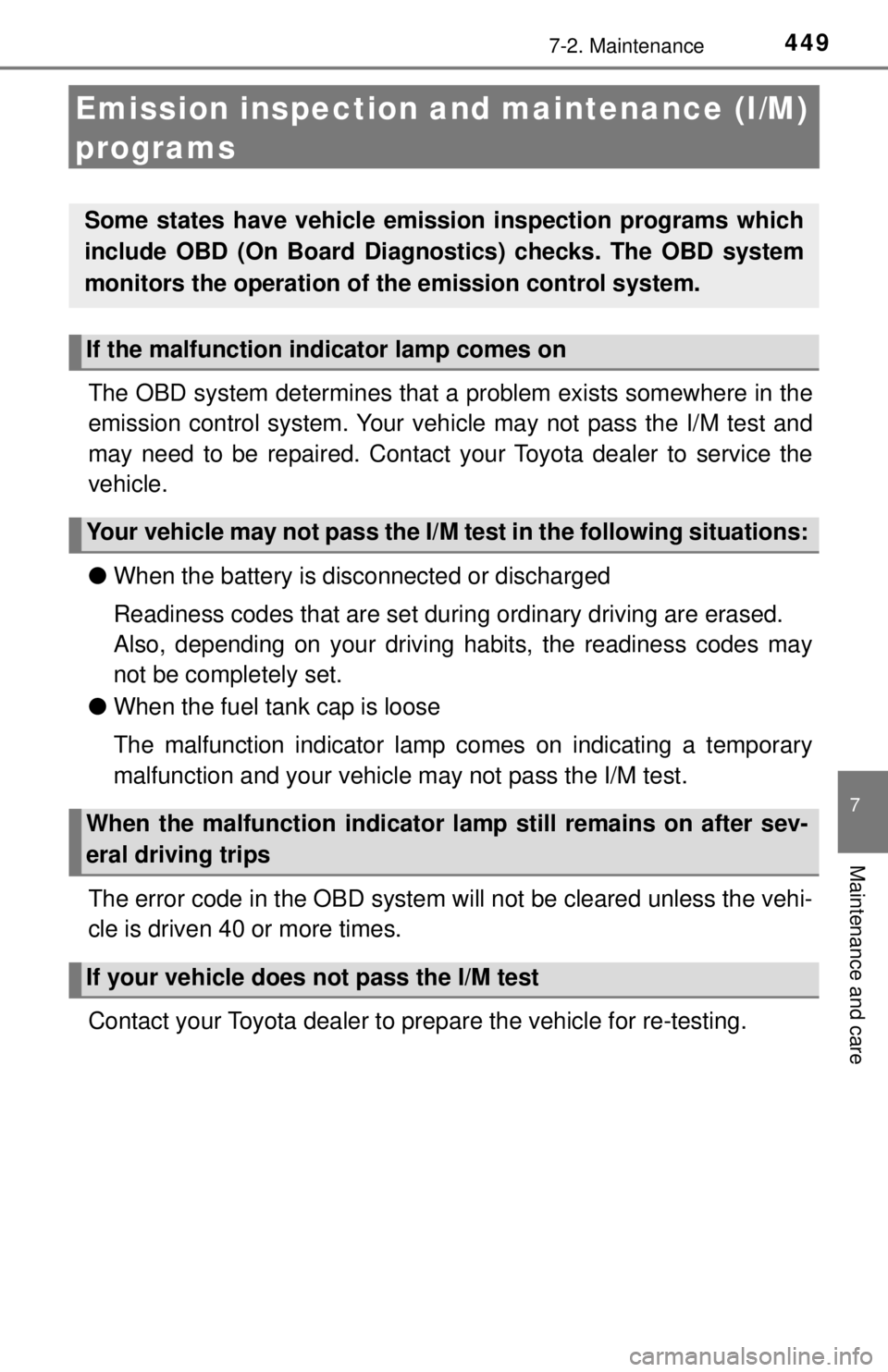
4497-2. Maintenance
7
Maintenance and care
Emission inspection and maintenance (I/M)
programs
The OBD system determin es that a problem exists somewhere in the
emission control system. Your vehi cle may not pass the I/M test and
may need to be repaired. Contact your Toyota dealer to service the
vehicle.
● When the battery is disconnected or discharged
Readiness codes that are set duri ng ordinary driving are erased.
Also, depending on your driving habits, the readiness codes may
not be completely set.
● When the fuel tank cap is loose
The malfunction indicator lamp comes on indicating a temporary
malfunction and your vehicle may not pass the I/M test.
The error code in the OBD system will not be cleared unless the vehi-
cle is driven 40 or more times.
Contact your Toyota dealer to prepare the vehicle for re-testing.
Some states have vehicle emission inspection programs which
include OBD (On Board Diagnos tics) checks. The OBD system
monitors the operation of the emission control system.
If the malfunction indicator lamp comes on
Your vehicle may not pass the I/M test in the following situations:
When the malfunction indicator la mp still remains on after sev-
eral driving trips
If your vehicle does not pass the I/M test
Page 477 of 640
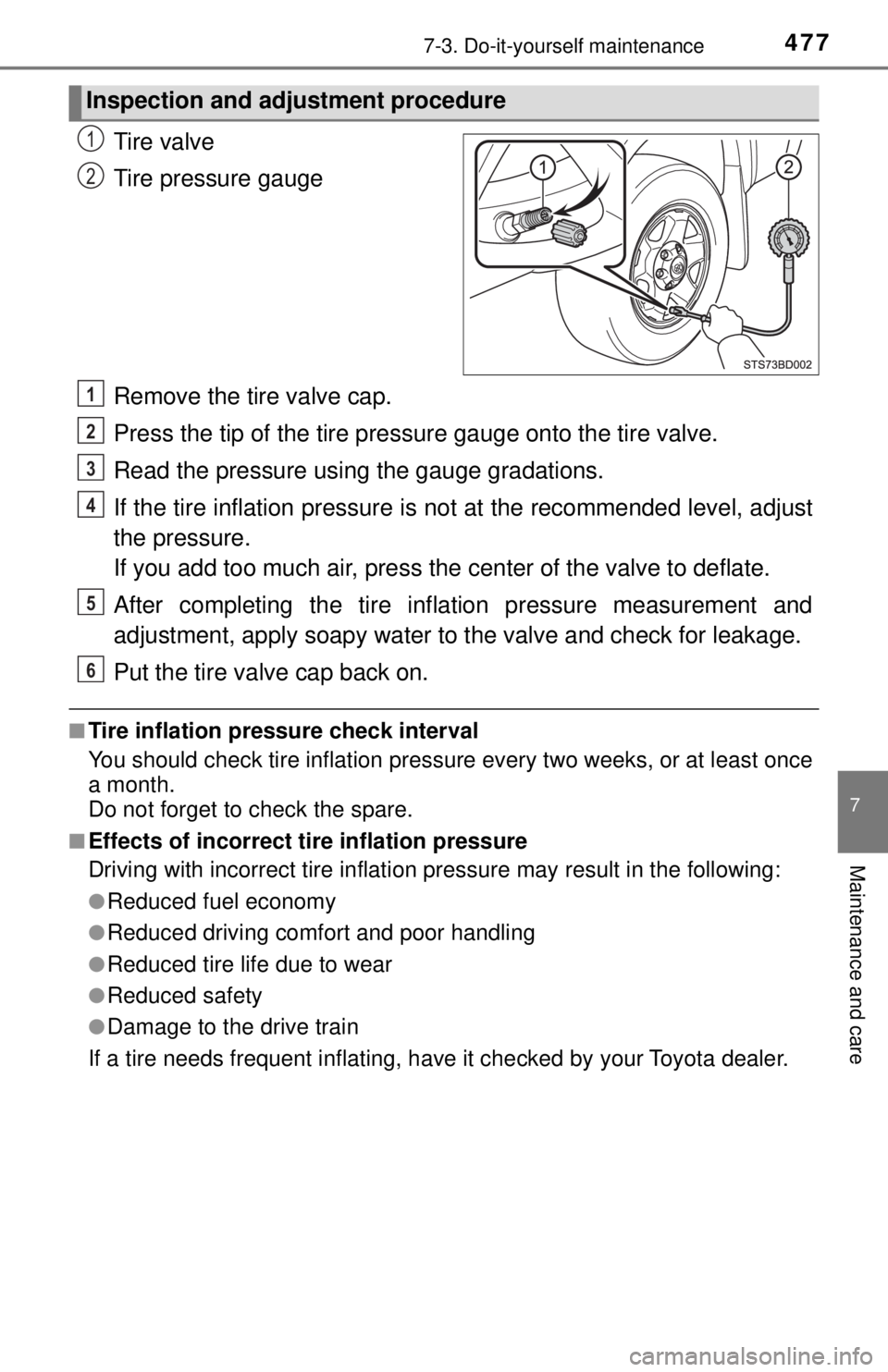
4777-3. Do-it-yourself maintenance
7
Maintenance and care
Tire valve
Tire pressure gauge
Remove the tire valve cap.
Press the tip of the tire pressure gauge onto the tire valve.
Read the pressure usi ng the gauge gradations.
If the tire inflation pressure is not at the recommended level, adjust
the pressure.
If you add too much air, press the center of the valve to deflate.
After completing the tire inflation pressure measurement and
adjustment, apply soapy water to the valve and check for leakage.
Put the tire valve cap back on.
■Tire inflation pressure check interval
You should check tire inflation pressure every two weeks, or at least once
a month.
Do not forget to check the spare.
■Effects of incorrect tire inflation pressure
Driving with incorrect tire inflation pressure may result in the following:
●Reduced fuel economy
●Reduced driving comfort and poor handling
●Reduced tire life due to wear
●Reduced safety
●Damage to the drive train
If a tire needs frequent inflating, have it checked by your Toyota dealer.
Inspection and adjustment procedure
1
2
1
2
3
4
5
6
Page 520 of 640

5208-2. Steps to take in an emergency
■If the malfunction indicator la mp comes on while driving
First check the following:
● Is the fuel tank empty?
If it is, fill the fuel tank immediately.
● Is the fuel tank cap loose?
If it is, tighten it securely.
The light will go off after several driving trips.
If the light does not go off even after several trips, contact your Toyota dealer
as soon as possible.
■
When the tire pressure warning light comes on (if equipped)
Check the tire inflation pressure and adjust to the appropriate level. Push-
ing the tire pressure warning reset switch will not turn off the tire pressure
warning light.
■The tire pressure warning light may come on due to natural causes
(if equipped)
The tire pressure warning light may come on due to natural causes such
as natural air leaks and tire inflat ion pressure changes caused by tem-
perature. In this case, adjusting the ti re inflation pressure will turn off the
warning light (after several minutes).
■When a tire is replaced with a spare tire (vehicles with the tire pres-
sure warning system)
The temporary spare tire is not equipped with a tire pressure warning
valve and transmitter. If a tire goes flat, the tire pressure warning light will
not turn off even though the flat tire has been replaced with the temporary
spare tire. Replace the temporary spare tire with the repaired tire and
adjust the tire inflation pressure. The tire pressure warning light will go off
after several minutes.
■Conditions that the tire pressure warning system may not function
properly (if equipped)
→ P. 4 7 2
■If the tire pressure warning light frequently comes on after blinking
for 1 minute (if equipped)
If the tire pressure warning light frequently comes on after blinking for 1
minute when the engine switch is tu rned to “ON” position (vehicles with-
out a smart key system) or IGNITION ON mode (vehicles with a smart
key system), have it checked by your Toyota dealer.
■ Warning buzzer
In some cases, the buzzer may not be heard because of noisy place or an
audio sound.
Page 572 of 640
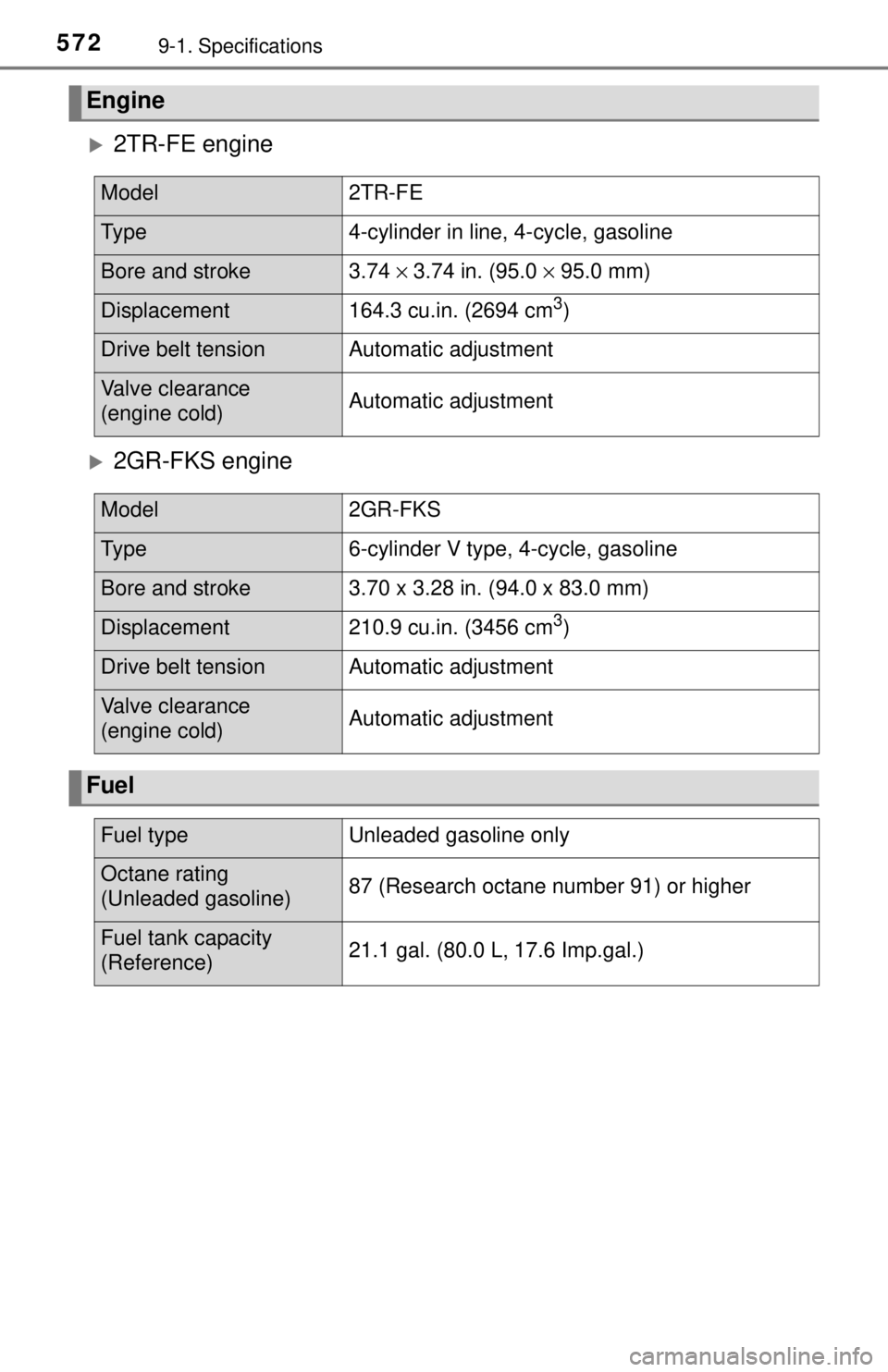
5729-1. Specifications
2TR-FE engine
2GR-FKS engine
Engine
Model2TR-FE
Ty p e4-cylinder in line, 4-cycle, gasoline
Bore and stroke3.74 × 3.74 in. (95.0 × 95.0 mm)
Displacement164.3 cu.in. (2694 cm3)
Drive belt tensionAutomatic adjustment
Valve clearance
(engine cold)Automatic adjustment
Model2GR-FKS
Ty p e6-cylinder V type, 4-cycle, gasoline
Bore and stroke3.70 x 3.28 in. (94.0 x 83.0 mm)
Displacement210.9 cu.in. (3456 cm3)
Drive belt tensionAutomatic adjustment
Valve clearance
(engine cold)Automatic adjustment
Fuel
Fuel typeUnleaded gasoline only
Octane rating
(Unleaded gasoline)87 (Research octane number 91) or higher
Fuel tank capacity
(Reference)21.1 gal. (80.0 L, 17.6 Imp.gal.)
Page 573 of 640
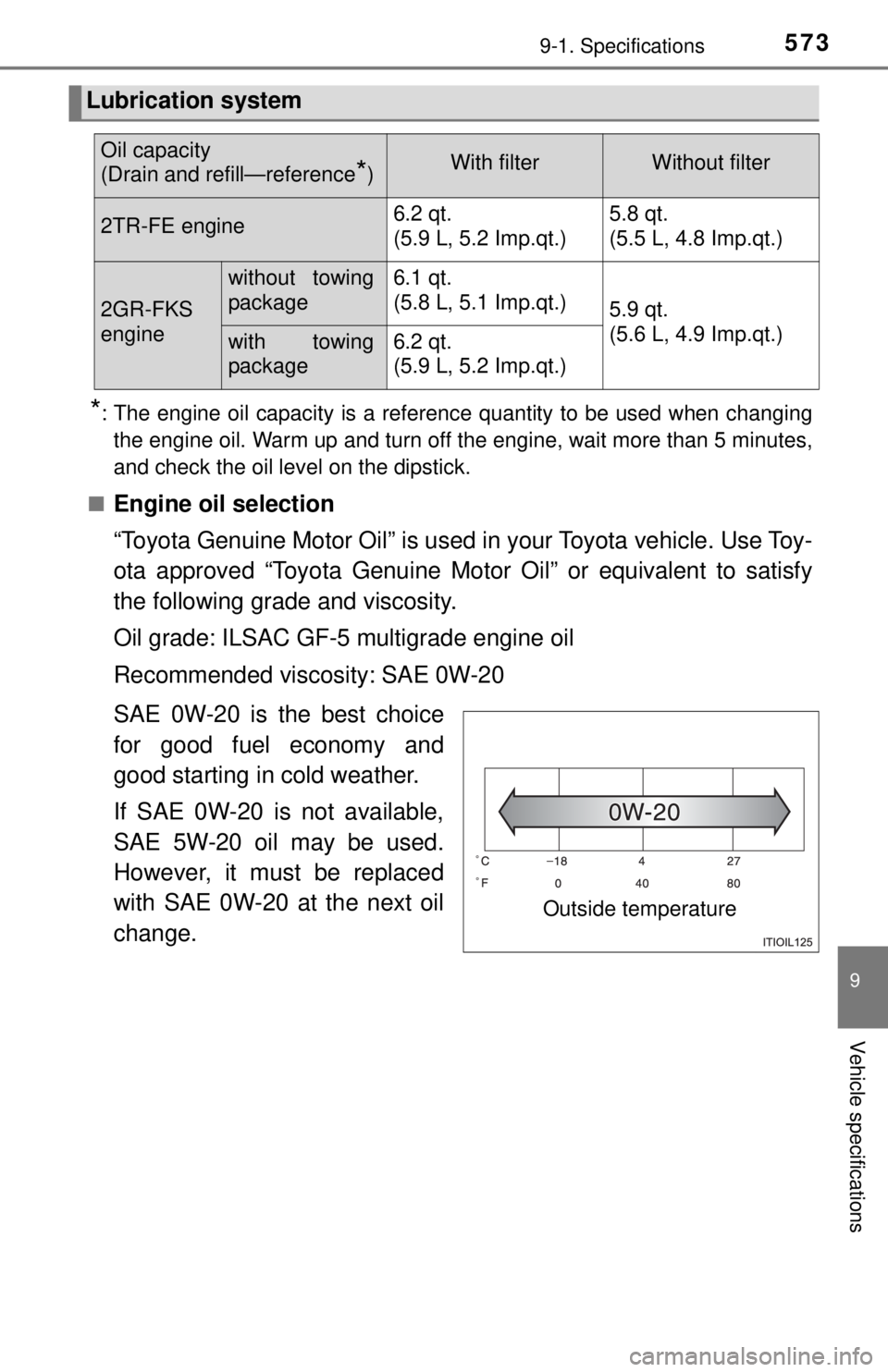
5739-1. Specifications
9
Vehicle specifications
*: The engine oil capacity is a reference quantity to be used when changingthe engine oil. Warm up and turn off the engine, wait more than 5 minutes,
and check the oil level on the dipstick.
■
Engine oil selection
“Toyota Genuine Motor Oil” is used in your Toyota vehicle. Use Toy-
ota approved “Toyota Genuine Motor Oil” or equivalent to satisfy
the following grade and viscosity.
Oil grade: ILSAC GF-5 multigrade engine oil
Recommended viscosity: SAE 0W-20
SAE 0W-20 is the best choice
for good fuel economy and
good starting in cold weather.
If SAE 0W-20 is not available,
SAE 5W-20 oil may be used.
However, it must be replaced
with SAE 0W-20 at the next oil
change.
Lubrication system
Oil capacity
(Drain and refill—reference
*)With filterWithout filter
2TR-FE engine6.2 qt.
(5.9 L, 5.2 Imp.qt.)5.8 qt.
(5.5 L, 4.8 Imp.qt.)
2GR-FKS
engine
without towing
package6.1 qt.
(5.8 L, 5.1 Imp.qt.)
5.9 qt.
(5.6 L, 4.9 Imp.qt.)
with towing
package6.2 qt.
(5.9 L, 5.2 Imp.qt.)
Outside temperature
Page 590 of 640
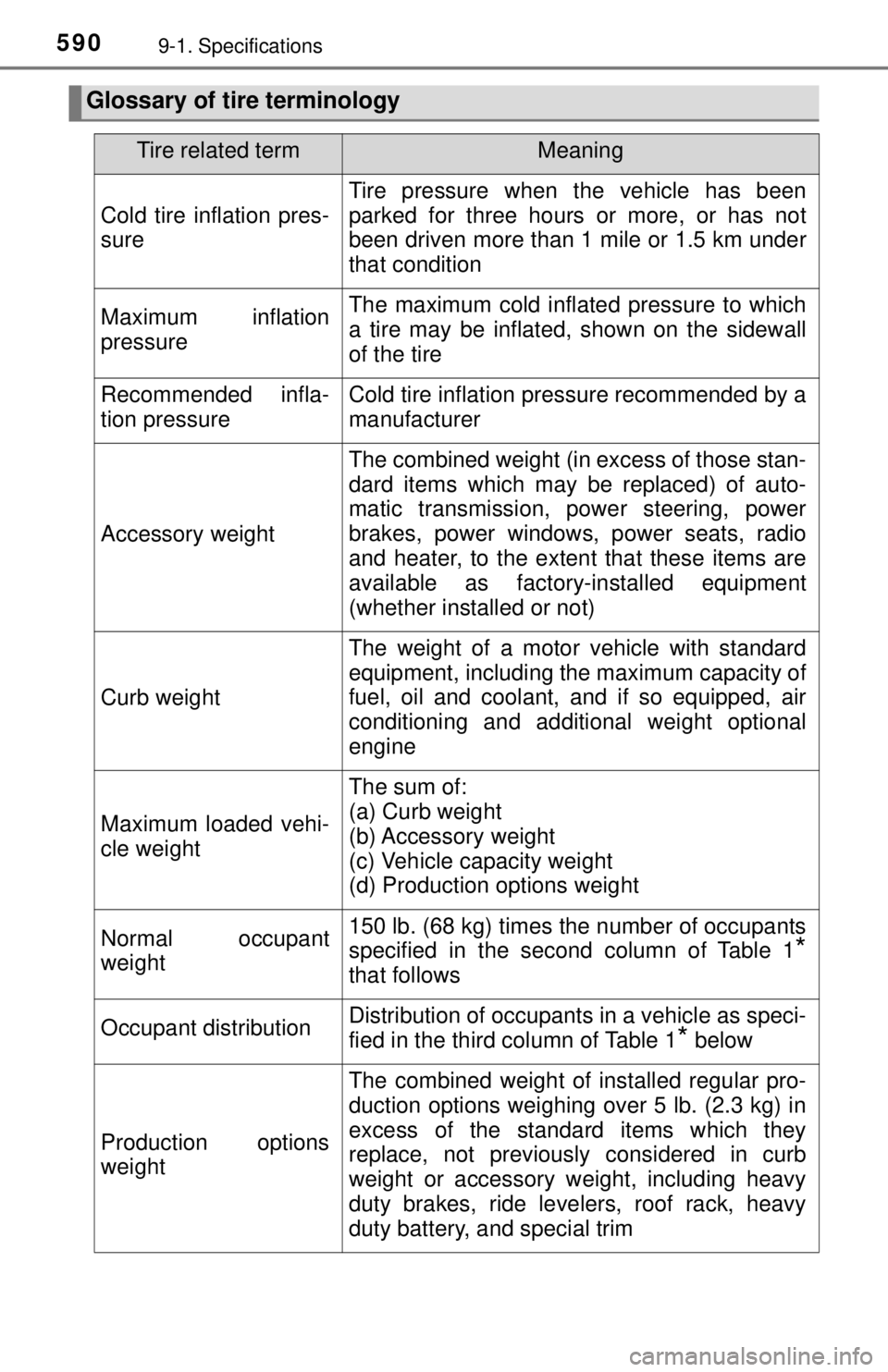
5909-1. Specifications
Glossary of tire terminology
Tire related termMeaning
Cold tire inflation pres-
sure
Tire pressure when the vehicle has been
parked for three hours or more, or has not
been driven more than 1 mile or 1.5 km under
that condition
Maximum inflation
pressureThe maximum cold inflated pressure to which
a tire may be inflated, shown on the sidewall
of the tire
Recommended infla-
tion pressureCold tire inflation pressure recommended by a
manufacturer
Accessory weight
The combined weight (in excess of those stan-
dard items which may be replaced) of auto-
matic transmission, power steering, power
brakes, power windows, power seats, radio
and heater, to the extent that these items are
available as factory-installed equipment
(whether installed or not)
Curb weight
The weight of a motor vehicle with standard
equipment, including the maximum capacity of
fuel, oil and coolant, and if so equipped, air
conditioning and additional weight optional
engine
Maximum loaded vehi-
cle weight
The sum of:
(a) Curb weight
(b) Accessory weight
(c) Vehicle capacity weight
(d) Production options weight
Normal occupant
weight150 lb. (68 kg) times the number of occupants
specified in the second column of Table 1
*
that follows
Occupant distributionDistribution of occupants in a vehicle as speci-
fied in the third column of Table 1
* below
Production options
weight
The combined weight of installed regular pro-
duction options weighing over 5 lb. (2.3 kg) in
excess of the standard items which they
replace, not previously considered in curb
weight or accessory weight, including heavy
duty brakes, ride levelers, roof rack, heavy
duty battery, and special trim
Page 630 of 640

630Alphabetical index
Flat tire...................................... 540
Floor mats .................................. 24
FluidAutomatic transmission......... 577
Brake .................................... 578
Power steering ...................... 578
Washer ................................. 465
Fog lights ................................. 210 Replacing light bulbs............. 497
Switch ................................... 210
Wattage ................................ 580
Four-wheel drive system ........ 247
Front passenger occupant classification system .............. 45
Front personal lights ............... 390
Front seats ............................... 129 Adjustment ............................ 129
Cleaning................................ 441
Correct driving posture ........... 26
Head restraints ..................... 134
Seat heaters ......................... 387
Front side marker lights
Light switch ........................... 206
Replacing light bulbs............. 495
Wattage ................................ 580
Front turn signal lights Replacing light bulbs............. 496
Turn signal lever ................... 204
Wattage ................................ 580
Fuel ........................................... 572 Capacity ................................ 572
Fuel gauge .............................. 88
Fuel pump shut off system.... 513
Information ............................ 581
Refueling............................... 214
Type ...................................... 572
Warning light ......................... 516
Warning message ................. 527 Fuel consumption
Average fuel consumption ................... 94, 98
Current fuel consumption ................... 94, 98
Fuel filler door ......................... 216
Fuel pump shut off system..... 513
Fuses ........................................ 488
Garage door opener ................ 425
Gas station information .......... 640
Gauges ....................................... 88
Glove box ................................. 393
Grocery bag hooks.................. 408
F
G
Page 634 of 640

634Alphabetical index
Parking assist sensors (intuitive parking assist) ....... 223
Parking brake ........................... 205 Operation .............................. 205
Parking brake engaged
warning buzzer ................... 516
Parking brake engaged
warning message ............... 529
Parking lights ........................... 206 Light switch ........................... 206
Replacing light bulbs..... 496, 501
Wattage ................................ 580
Personal lights ......................... 390
Wattage ................................ 580
Power back window ................ 149
Power mode switch ................. 198
Power outlets ................... 412, 413
Power steering fluid ................ 461
Power windows........................ 145 Jam protection function......... 146
Operation .............................. 145
Power back window switch ................................. 149
Window lock switch............... 145 Radiator .................................... 460
Radio
*...................................... 302
Rear differential lock system ........................... 253
Rear seat Adjustment precautions ........ 133
Child seats/child restraint system installation ................ 55
Cleaning ............................... 441
Folding down ........................ 131
Head restraints ..................... 134
Raising the bottom cushion ............................... 131
Rear side marker lights........... 206 Light switch ........................... 206
Replacing light bulbs ............ 499
Wattage ................................ 580
Rear step bumper .................... 120
Rear turn signal lights ............ 204 Replacing light bulbs ............ 499
Turn signal lever ................... 204
Wattage ................................ 580
Rear view mirror Inside rear view mirror .......... 140
Outside rear view mirrors ..... 143
Rear view monitor system ...... 229
Refueling .................................. 214 Capacity................................ 572
Fuel types ............................. 572
Opening the fuel tank cap..... 216
PR